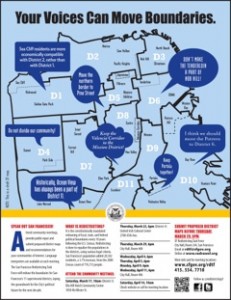
According to Terry Valen:
The impact really hit the task force in terms of the depth and breadth of support for the Community Unity map and the process that went through to create a city-wide proposal. Filipino community’s presentation and public testimony stood in stark contrast to the Realtors map and the David Lee/CAVEC map presented, both of which had little public testimony in support.
Also, the task force literally took them to task on the real interests behind the Realtors map (is it really their renters and homeowners or the input of 4000 real estate agents defining neighborhoods for profit), and David Lee’s lack of preparation to answer basic task force questions on how he created his map (aside from vague references to 20 years of voting data).
One troubling part of the Realtors presentation was that aside from the Realtors “survey” that they used to justify their definition of neighborhoods, they also regularly cited their interest in preserving ethnic communities including “Hispanics” and regularly citing Filipinos as a community they really wanted to protect in terms of preserving our numerical concentrations in all districts.
However, the northern piece they cut off of D11 (some of the high concentration census tracts in D11) are along the Filipino-concentrated Mission corridor we’ve discussed in previous Filipino Redistricting Forums. The recent discussions (over email) about D6 and D10 and the Filipino future in these districts should be discussed as well.
Although the Realtors are naming the Filipino community as a community of interest that they care about in drawing their map, the Filipino community should raise their own voice and speak for what is really best for the community —in terms of a citywide map that works best in the short- and long-term interest. No Filipinos testified in support of the realtors’ or CAVEC’s map.
Marily Mondejar has done a tremendous job in representing a Filipino and larger SF community voice on the task force. The least we can do is come together one last time and weigh in as a united community to finish this process that she and Al Perez started to lift up our Filipino voice together in the redistricting task force hearings, from all of the different places that we come from in Filipino San Francisco.
There is a request that more community members represent a united position at one of the early April task force meetings (April 4), well in advance of the final task force meeting and decision by April 15th.
Organizers are looking forward to closing out this process with a strong and united Filipino Redistricting Forum position. There are around 34,000 Filipinos in San Francisco who will be directly impacted by the redistricting. However, there are also several historic Filipino sites that will be affected should the redistricting map being worked on by the Filipino Redistricting Forum not be adapted.
The final map which will be voted on in April 15, will be in effect for the next 10 years. In the recently redistricting of California, the Filipino community already lost two districts with representatives supportive of the Filipino community, namely State Senator Leland Yee, and Protemp Fiona Ma. The battle cry here is “The community already lost in the state redistricting. Let this not happen to San Francisco.”

